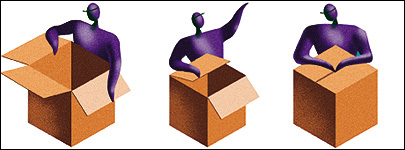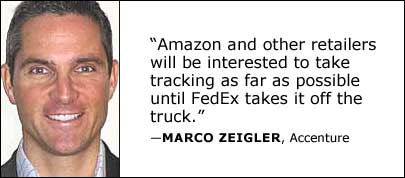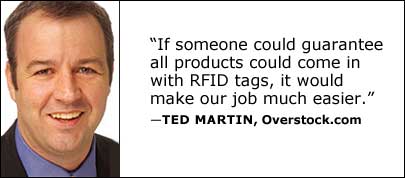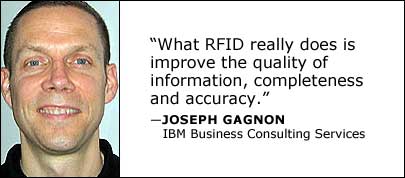Dec 01, 2005To the customer, buying goods at online discount retailer Overstock.com is a seamless experience. One click: Place a book or a watch or a poker set into an electronic shopping cart. Next click: Proceed to checkout. A few more clicks: Pay for the item with a credit card, and get an estimated delivery date. On the back end, however, the supply chain at Overstock.com—as at many other Internet retailers—is not quite as seamless.
Overstock.com, based in Salt Lake City, buys closeouts of brand-name merchandise from assorted suppliers, and then offers those goods to online customers at a discount. Some items don't even have bar codes when they arrive at Overstock.com's warehouses in Salt Lake City and Indianapolis; bar code labels have to be applied manually to that merchandise. Complicating matters is that customer orders are usually for one or more distinct items. Overstock.com workers must locate the goods in the warehouse, hand-pick the individual items out of a case or pallet, hand-pack the items and turn over the package to a parcel service, which is ultimately responsible for delivery.

RFID has the potential to help Internet retailers automate the back end so the order fulfillment process is as efficient as the ordering process is on the front end. "This is an opportunity for Internet retailers to leverage RFID to more effectively pick, pack and ship faster," says Joseph Gagnon, global and Americas retail industry leader at IBM Business Consulting Services.
While Overstock.com and other technology-savvy e-tailers are excited about the potential of RFID, they say that right now the high cost of implementing the technology doesn't make economic sense. In addition to the cost of hardware, Overstock.com has to weigh the cost of reengineering business processes, data management and software integration against what the company stands to gain, says Ted Martin, the company's senior vice president of merchandising and operations.
And e-tailers say they stand to gain less from RFID than brick-and-mortar retailers—those with physical stores—that have given their larger suppliers mandates to tag pallets and cases of goods. The e-tail business model is based on finding and shipping individual items directly to consumers, whereas the brick-and-mortar world involves keeping pallets and cases of goods stocked in distribution centers, warehouses and individual retail stores. Analysts say e-tailers are more likely to realize benefits from RFID once manufacturers are tagging at the item level because it will allow them to stock items more efficiently in warehouses and locate items more quickly.
"The role of RFID in an Internet retailer is not item-level tagging for the purpose of checkout," says Gagnon. "It's more of finding items and redesigning for maximum efficiency of the layout of warehouses and regional distribution centers."
The online order-fulfillment process is unique to Internet retailers, and one of their most difficult and costly problems. In other areas, even though e-tailers often have different processes than brick-and-mortar retail chains, they could see some of the same benefits from RFID, analysts say. Internet retailers could use RFID to help the bottom line by reducing theft and other product losses in the supply chain, achieving better retail count accuracy and inventory control, and verifying the authenticity of goods being returned. RFID could also solve another problem that stores don't have: Online retailers have to hand off shipments to parcel services, and sometimes items get lost, misidentified or delivered to the wrong address. RFID would provide more accountability in terms of delivery for online retailers.
Some of the most successful online retailers—including Amazon.com and Dell—are among the world's most innovative businesses in their use of information technology to streamline e-commerce and supply chain processes. Both of those companies have experimented with RFID and, in Dell's case, use it in some limited manufacturing. But they have yet to fully embrace RFID as a supply chain solution.
Amazon.com, which spends about $200 million a year on business technology, has deployed RFID-enabled applications—the company won't detail which ones—but the technology isn't yet a companywide priority. Amazon.com spokesperson Patty Smith says that company executives believe RFID is useful for organizations that have poor inventory accuracy and a high shrink rate—the rate at which items are lost, damaged or disappear from the supply chain—and need more real-time information. Those aren't problems for Amazon.com today.

Amazon.com has said in published interviews that it envisions RFID will hold more promise when tagging is done at the item level and not only on cases and pallets, as Wal-Mart, Best Buy, Target and most of the other brick-and-mortar companies are currently mandating. "We continue to watch the technology," says Smith, "so that we can use it when the time is right."
The world's most successful online computer seller, Dell, has also been experimenting with and studying RFID, but a company spokesman says the company is waiting for the cost of implementing RFID to drop before moving to incorporate the technology into its supply chain. Dell has been using RFID for manufacturing and shipping at some of its production facilities since 2002. Dell uses trays with RFID tags attached to the bottom, and those help route computer components to different assembly sections and then on to shipping.
Some consumer electronics companies have embraced RFID—retailer Best Buy begins a pilot next year, and some manufacturers, such as Hewlett-Packard, have been integrating RFID fully into their supply chains. Dell concluded that for most cost-benefit situations, the technology "falls into the category of hold." But Dell sells products online, through catalogs and over the telephone, whereas Best Buy must manage the stock of electronics products in hundreds of different stores in response to consumer demand for top-selling items and before other products become obsolete.
For a manufacturer that ships direct to customers, such as Dell, one potential benefit of RFID is the ability to track and trace parts or components based on serial numbers. Dell conducted an internal study and concluded that the company could use RFID data on tagged items that are repaired or returned to help calculate the reliability of hard drives or DVD burners. That type of information could help the company determine which suppliers make better components.
Andy North, a Dell spokesman, adds that the company is "certainly exploring it" but is waiting to jump in at a crucial point where prices drop down a bit so that the company can leverage the technology more cost-effectively. "We are excited about it," North says. "We are just in the initial phase of piloting and pioneering the technology....It's an exciting technology, but we need to make the numbers work."
The online order fulfillment process stands to gain the most benefit from RFID, analysts say, but only once tagging is done at the item level—either by the manufacturer or the retailer. Locating stock has long been a problem for catalog retailers and now e-tailers. In addition, some e-tailers don't maintain merchandise on hand but order goods from a manufacturer or book publisher once they receive a customer order. Sometimes those items are shipped from the manufacturer to the e-tailer and then to the customer. RFID could take a step out of this inefficient process by enabling goods ordered online to be shipped directly to the customer from the manufacturer, according to Marco Zeigler, a partner in Accenture's retail and consumer goods practice who is in charge of RFID in those industries. RFID tags could be applied by the manufacturer and encoded to reflect such information as which online retailer the item was ordered from and where the item is going.
Retail executives—including those who operate dot-coms—say theft accounts for the majority of the shrink in their businesses, according to a National Retail Federation survey released in May. In the dot-com supply chain, theft can occur at many points, from warehousing and transportation through to the delivery process. Expensive and luxury items—such as small appliances, computers, cosmetics, jewelry and video games—are most vulnerable to theft and also account for the highest portion of online sales, according to a Forrester Research study released in September. These types of items could be tagged in order to protect against theft.
Mix-ups on the delivery end are another big source of shrink for online retailers. These merchants tend to use parcel services, such as UPS, FedEx, the U.S. Postal Service or DHL, to ship goods directly to consumers. Most of these services use bar code technology to ship small parcels, although they are experimenting with RFID. But bar codes verify only the SKU or a general product category, not necessarily the specific color, make, model and size of what was ordered. Sometimes the wrong item is sent to someone who ordered online, and the problem isn't identified until the package is opened by a disappointed customer. Sometimes packages are delivered to the wrong address. The online retailer is ultimately held responsible.
Zeigler believes that online (and catalog) retailers must work on RFID solutions that involve logistics suppliers, so that the retailers can have more visibility in the supply chain all the way to ensuring that the right package was delivered to the right customer. "This is a big opportunity to connect the Amazons, the online retailers, to those companies executing the supply chain," he says. Right now, when a customer orders a book or other product online, the online retailer can track the order until it exits the warehouse. Then the tracking shifts to the delivery company. "Amazon and other retailers will be very interested to take that tracking as far as possible until FedEx takes it off the truck," says Zeigler. He adds that logistics partners must agree to share tracking data electronically with online retailers: "They only generate business benefits working together as business partners."
Returning products to online retailers has been a thorny issue from the start. Initially, products couldn't be returned, except at the cost of the consumer shipping them back. Most online retailers have worked through the problems and now include instructions and mailing labels for returns, and offer package pickup through one of the parcel services. But analysts say the return process is labor-intensive and rife with customer fraud. Internet retailers could use RFID to verify the authenticity of a product, its warranty status and from where and when it was purchased.
"With online retail, returns and shipping and logistics are much more important than in a store," says Elliot Klein, founder of Intellareturn, which sells RFID-enabled warranty and return solutions to companies. "Our view is that RFID can help and automate many customer processes that you wouldn't have in a retail store environment." Klein says he does not have any online retailer customers yet.
While Internet retailers such as Amazon.com and Dell are poised to deploy RFID in their online retail supply chains once prices drop and tagging is down to the item level, analysts believe that some of the first online companies that take up RFID will be the Web sites of brick-and-mortar retailers. Right now, the brick-and-mortar retailers that are piloting RFID—Wal-Mart, Target, Best Buy—are confining the experiments and deployments to the supply chain feeding their physical, not virtual, stores. Some companies such as J. Crew in the United States and Tesco and Marks & Spencer in the United Kingdom are testing the application of applying RFID tags on individual items sold in stores, but not yet on goods sold through their Web-based stores.
Retailers are likely to transition to item-level tagging in stores before they start tagging merchandise sold online. "I think the physical stores will ultimately drive the process," says Alexi Sarnevitz, research director of retail at AMR Research. "For manufacturers, once this becomes common and the bar code and RFID tag are on a single label because of the need of the physical stores, they will tag everything. All of the products will have tags, and they will start taking advantage of that in the dot-com environment." For some e-tailers, that day can't come soon enough. "If someone could guarantee that all products could come in with RFID tags, it would make our job much easier," says Overstock.com's Martin. "But I'm not sure how close that day is."
Personalization or Privacy Invasion?
Internet retailers started investing in sophisticated analytics and personalization tools earlier this decade. The ability to customize the shopping experience is what Internet retailers hope will encourage shoppers to return. Amazon.com and many other e-tailers now use consumer data to enhance the online shopping experience by recommending products, such as novels or music CDs, that are similar to items customers purchased previously. At BlueNile.com, young couples can design and build their engagement rings. And at the Lands' End Web site, clothing shoppers can create a virtual model using their body measurements and "try on" jeans, swimsuits and other garments before making a purchase.
RFID can help further personalize the online shopping experience. "What RFID really does is improve the quality of information, completeness and accuracy," says Joseph Gagnon, global and Americas retail industry leader at IBM Business Consulting Services. But, he points out, it is essential that e-tailers address consumer privacy concerns up front and explain to customers exactly what they plan to do, how it works and what happens to the information.
Privacy advocates have long lamented that some Internet retailers have "customized" the online shopping experience by tracking and analyzing data about where people go in cyberspace, what goods they look at and what they buy and for what price. But privacy advocates are even more wary of RFID. They fear that RFID tags on credit cards, IDs and retail items pose an even greater threat to personal privacy. That's because instead of just tracking virtual movements on the Internet, information contained on RFID tags could identify a person and then pinpoint that person's physical location.
The fact that e-tailers see potential for uses of RFID when tagging is done at the item level raises questions about whether they will be sending items to customers that contain RFID tags. If they do, Gagnon says, companies need to take pains to inform their customers about the privacy implications of the tags—what they are being used for, what data will be kept and how to remove or kill the tags, if need be.
While privacy advocates are still wary of online customization, and some customers have decided not to shop at Web sites that collect personal data, the bottom line is other customers have come to accept that sites such as Amazon.com will recommend products based on their past purchases. Gagnon says that retailers may find similar acceptance of item-level tagging if they are up front about the use of the tags and disclose to customers information about what data will be collected and for what purposes.



